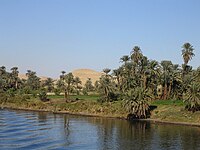
Photo from wikipedia
A specific study was designed and carried out at the Loire River Basin in France, in order to estimate the measurement uncertainty, including the contribution of sampling. Following recommendations from… Click to show full abstract
A specific study was designed and carried out at the Loire River Basin in France, in order to estimate the measurement uncertainty, including the contribution of sampling. Following recommendations from the Eurachem Guide on Uncertainty arising from sampling, the duplicate method was selected. The study was conducted in 2017 under routine and operational conditions with the accredited laboratories selected by the Loire-Bretagne Water Agency. In overall, 35 monitoring stations were chosen for estimating the spatial variability, and among them 11 monitoring stations were singled out for estimating the temporal variability from April to December. To reduce both the number of analysis and the costs of this study, an unbalanced design was used. Finally, a robust analysis of variance was used to evaluate the measurement uncertainty by means of RANOVA2 software. For some parameters (e.g., calcium, dissolved organic carbon, nitrates, phosphates, suspended matter, metals), the expanded measurement uncertainty estimated using robust ANOVA was found to be lower than 20 % and was thus used to calculate the lower and upper confidence interval limits at 95 %. For parameters having an expanded measurement uncertainty greater than 20 % (e.g., most pesticides, chlorophyll a, biochemical oxygen demand, ammonium, nitrites, Kjeldahl nitrogen), the lower and upper confidence interval limits at 95 % were established using an alternative approach: the expanded uncertainty factor (FU) derived from log-transformed data.
Journal Title: Accreditation and Quality Assurance
Year Published: 2020
Link to full text (if available)
Share on Social Media: Sign Up to like & get
recommendations!